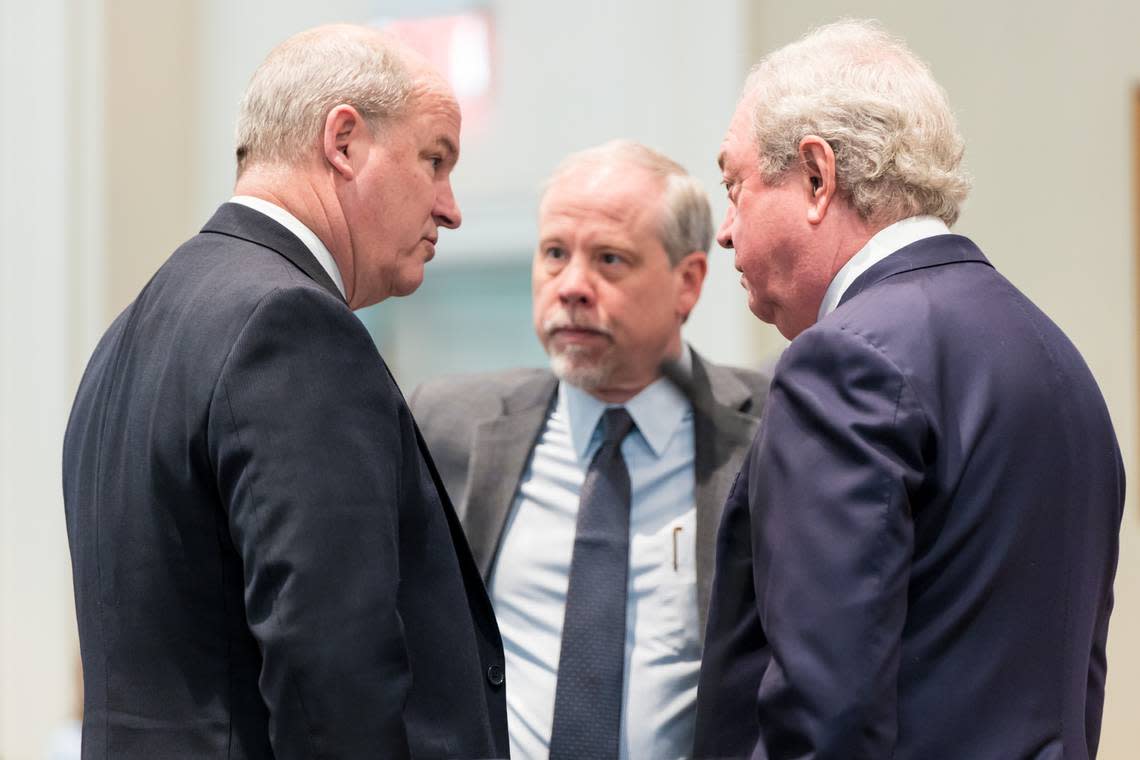Pathologist details Maggie, Paul autopsies; 2 Murdaugh murder trial jurors out with COVID
Editor’s note: This article contains strong language about autopsy evidence.
The highest-profile South Carolina murder trial in years hit a new snag Monday — the COVID-19 pandemic.
Judge Clifton Newman announced Monday that two jurors in the Alex Murdaugh double-murder trial have been excused after they tested positive for COVID-19. They were replaced with two alternate jurors who have heard the previous three weeks of testimony, as chosen by the court’s clerk.
Two alternates, a truck parts store employee and a telecommunications provider, were both chosen at random from the alternates to join the main jury pool.
Murdaugh has been charged with two counts of murder in the June 7, 2021, shooting deaths of his wife, Maggie, and son, Paul.
Prosecutor and defense attorneys raised concerns Monday about the effect the virus could have on the trial if more jurors get sick from the contagious disease spread by airborne particles. Murdaugh’s guilt or innocence must be determined by a unanimous verdict from 12 jurors at the Colleton County Courthouse, all of whom have sat in close proximity to each other in the jury box for the last three weeks.
Earlier in the trial, an alternate juror was dismissed when they missed court due to an emergency room visit. The trial, which started Jan. 23, began with six alternates, which has now been cut to three.
Defense attorney Dick Harpootlian suggested the court delay proceedings in case more jurors develop symptoms.
“I got COVID the second week of December, and it took me three weeks to get over it,” Harpootlian said, donning a black surgical mask.
“As a trial that goes on and on and on, we run the natural risk of attrition, whether it is COVID or some other problem,” Newman said. “We’ll just have to take precautions, as we all do, as we navigate through life in this period of time.”
Newman, who said he consulted a physician with COVID-19 experience, said jurors were tested for COVID-19 Monday and would be tested again Wednesday. He said many of the remaining jurors had agreed to wear masks in the courthouse for the rest of the trial, and encouraged others in the large public crowd in the courtroom Monday to do the same, although he stopped short of issuing court orders for social distancing, clearing the gallery of onlookers or requiring masks.
By day’s end, only a fraction of the 200 or so people in the audience were masked.
“Aren’t we all exposing ourselves in the courtroom here?” Harpootlian asked at one point.
“Probably so,” Newman said.
“We could do a little thermometer thing at the door,” lead prosecutor Creighton Waters suggested on the trial’s 16th day.
It was the second interruption at the courthouse, after a reported bomb threat disrupted court for hours last week.
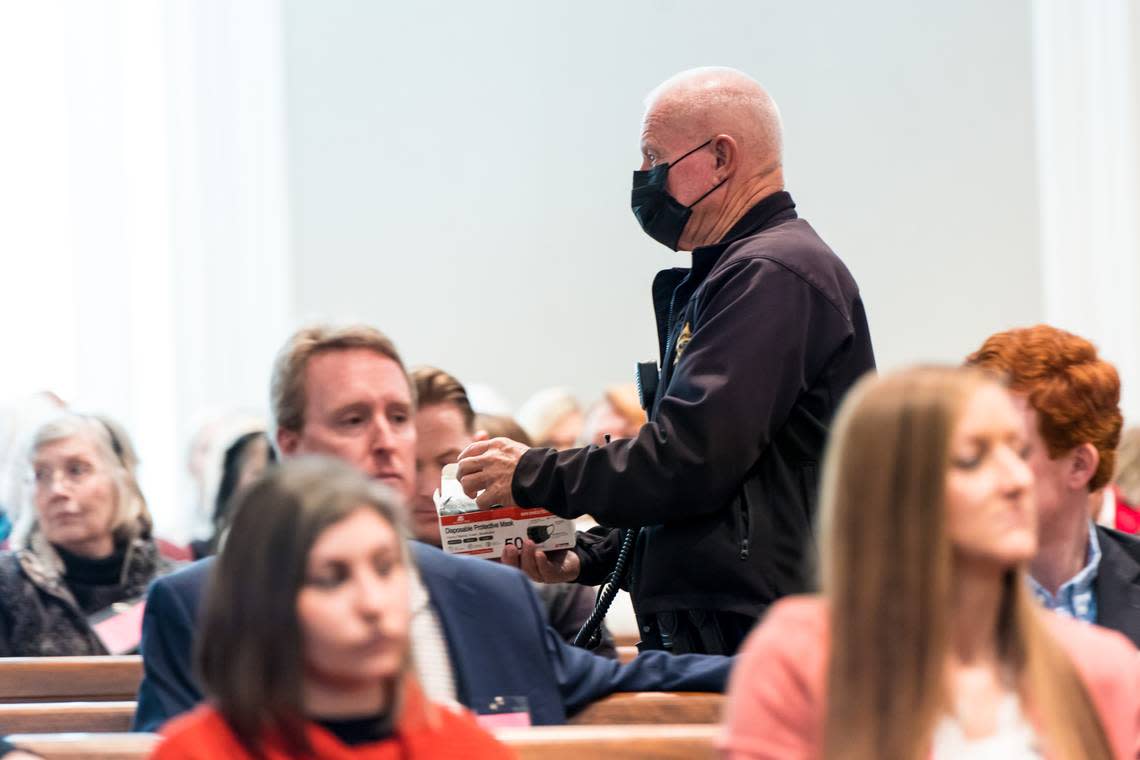
Pathologist explains how Paul, Maggie died
Monday’s most dramatic moment came late in the afternoon.
As pathologist Dr. Ellen Riemer testified in detail about how Paul and Maggie were shot to death, some jurors were seen crying, leaving Newman to briefly recess the trial and send the jury became into their room. One juror was seen putting her arm around another to comfort her.
Paul, 22, was shot at close range twice and would have survived if the second blast of a shotgun to his shoulder and head hadn’t killed him instantly, testified Riemer, a Medical University of South Carolina pathologist who has done some 5,500 autopsies.
Paul’s forearm “was down by his side at the time he sustained the wounds,” Riemer testified under questioning by Waters.
The second shotgun blast struck his shoulder, face and head, separating his brain from his head, she testified.
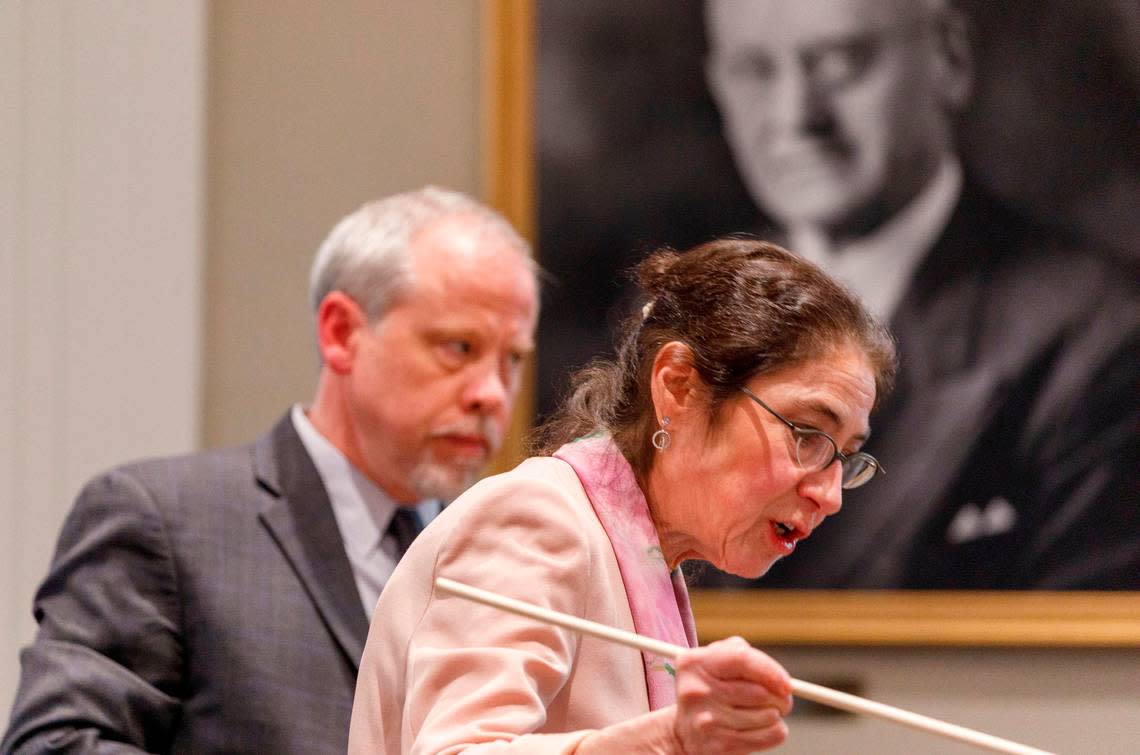
Maggie, 52, was killed by bullets “from a completely different weapon,” an assault rifle, testified Riemer, the state’s 51st witness.
The two bullets that struck Maggie — one in the stomach area and the other to the upper thigh — were also fired at close range, Riemer testified. Both wounds had the marks of gunpowder, a sign of a weapon fired at close range, she said.
A third bullet struck Maggie in the upper right chest and traveled to the face and into the head and brain, Riemer testified, adding those shots would have been fatal. A fourth bullet, likely fired when Maggie was bent over and not yet on the ground, hit the back of her head and traveled into her skull, Riemer testified as Waters showed with his own body where the bullets hit.
“Either one would have been immediately fatal,” Riemer testified.
Maggie also sustained another wound, on her right wrist, from a bullet, Riemer testified.
While the jury was shown photos of Paul and Maggie’s bodies, the public will not see them after they were put under seal by Newman by agreement of both prosecution and defense.
As Riemer testified, Murdaugh, sitting between his two defense attorneys, shook and dabbed at his eyes.
Siting a few rows back with family members, Buster, Murdaugh’s surviving son, kept his head down.
Riemer, who testified nearly two hours Monday, will undergo cross-examination by defense attorney Harpootlian Tuesday.
Blood, DNA analysis offered
On Monday, the jury was presented with an exhaustive series of data points about blood and DNA evidence that, at times, appeared to raise more questions about the physical evidence tying Murdaugh to the murders on June 7, 2021.
To explain the evidence, three agents with the S.C. Law Enforcement Division testified about the process of collecting and analyzing the blood and DNA evidence.
One, agent Rachel Nguyen said two blood stains were identified on the shirt Murdaugh was wearing the night of the murders, as well as on the steering wheel of his car. Blood was also found on an interior pocket of the shorts Murdaugh was wearing.
Nguyen said further analysis was done after first responders to the scene of the crime conducted a positive field test, which she said could lead to a false positive.
Nguyen did not indicate if the blood was identified as belonging to Murdaugh or either of the murder victims, but she forwarded them on for further analysis. Several guns confiscated from Murdaugh’s house were also tested for blood.
The receiver of a camouflage-printed Benelli shotgun tested positive for blood, Nguyen testified. But she said she couldn’t say whether it was human or animal blood. The Murdaugh family were avid hunters.
Under questioning by prosecutor Savanna Goude, Nguyen also testified that no blood was found on the blue raincoat found at Murdaugh’s mother’s house.
The defense has disputed whether the raincoat, which an expert witness said tested positive for gunshot residue, is even connected to Murdaugh — the witness who saw him carrying an item into his mother’s house could not say whether it was the raincoat or a blue tarp that was also found in the house.
An earlier witness, SLED agent Ryan Kelly, testified that investigators had collected DNA cheek swabs from members of the family of 2019 boat crash victim Mallory Beach as well as Curtis Smith, the distant cousin accused of participating in the Labor Day 2021 weekend shooting of Murdaugh in what has been reported as a botched suicide attempt to collect on a $10 million life insurance policy. Smith has denied that he shot Murdaugh.
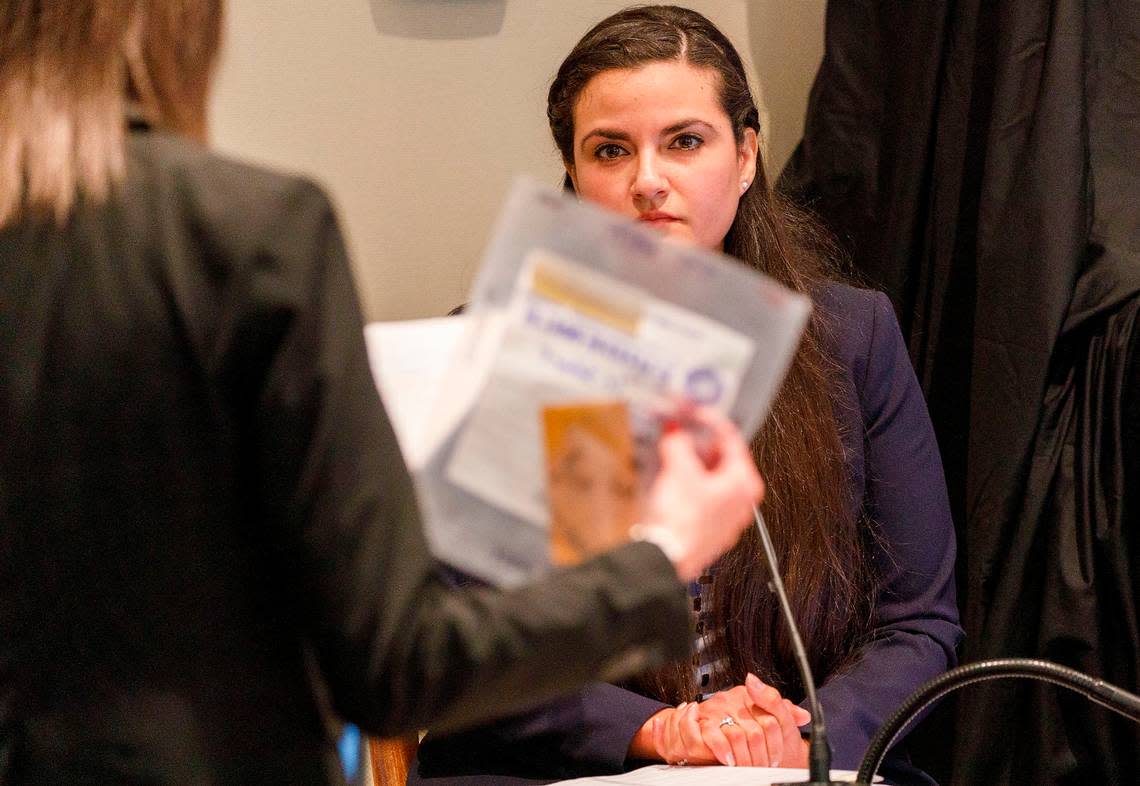
But the crux of the analysis came from SLED analyst Sara Zapata, who testified to the extensive DNA analysis that was performed on a number of items, such as Murdaugh’s white T-shirt and shoes, recovered in the course of the investigation.
Of the notable parts of her testimony, Zapata said an “unrelated” man’s DNA was found under Maggie’s fingernails.
Both Murdaugh and Paul’s DNA was ruled out, Zapata said.
DNA of C.B. Rowe, a handyman who worked for the Murdaugh family on their Colleton County property, known as Moselle, also was considered by Zapata after she said that she could not immediately exclude it. Later tests showed that a randomly chosen individual used as a control was eleven times more likely to have contributed the DNA, excluding Rowe as a likely match, she said.
On cross-examination, defense attorney Phil Barber asked Zapata whether she was aware that Maggie had been to a nail salon the afternoon of June 7, 2021. If her nails had been cleaned, Barber appeared to imply, the DNA must have come from her attacker. Paul only had his own DNA under his fingernails, according to Zapata.
Zapata also testified that no DNA was recovered from the blue raincoat taken from Murdaugh’s mother’s home. The jacket, which had the cuffs, a collar, a hood and zippers, were all swabbed, Zapata testified.
She also said no human blood was identified inside of Murdaugh’s Chevy Suburban, which he drove to the kennels, and Maggie’s DNA was found on spent .300 Blackout cartridges found at the crime scene.
The unknown DNA recovered from samples collected at the scene were not submitted to CODIS, the national DNA database, Zapata told Barber.
Much of the focus of Zapata’s testimony centered on the white T-shirt Murdaugh was wearing when law enforcement arrived at the dog kennels after Maggie and Paul were found shot to death. Zapata said investigators cut almost a dozen sections from the shirt that tested positive on a presumptive test for blood.
Sections cut from the shirt were tested for DNA, which much of it came back as most likely belonging to some combination of Murdaugh, Paul and Maggie, Zapata said. All three of the family members were not found to be present on every sample, according to Zapata.
“It would not be uncommon” to find a wife’s DNA on her husband’s shirt, Zapata conceded on cross-examination.
But one section, Zapata said, was found to have Nolan Tuten’s DNA on it, along with Murdaugh’s.
Tuten, who testified Friday, was a close friend of Paul’s who also worked as a “runner” for Murdaugh at his former law firm.
“I can never say how or when DNA got on an item,” Zapata said.
The T-shirt was the subject of extensive debate before the trial began. In pre-trial motions, the defense argued that there was no evidence of blood on the T-shirt, despite the report of an outside expert, former Oklahoma police Capt. Tom Bevel, who was employed by SLED and reported he observed evidence of blood spatter on the T-shirt.
This was despite initial tests performed by SLED that found that no human blood was detected on samples cut from the shirt, Zapata said Monday.
The defense fought to exclude Bevel’s blood spatter analysis of the shirt. In motions, the defense said Paul’s DNA was only found on the bottom of the shirt, confirmed by Zapata Monday.
Defense attorneys accused Bevel of using unscientific methods, and said he was pressured by SLED into producing a report favorable to the state’s theory after an early draft by Bevel said that he had found no evidence of blood spatter produced by being close to a gun shot.
The defense has also challenged the state’s testing of Murdaugh’s shirt, disputing the analysis and arguing the process left them unable to perform their own tests on the piece of evidence.
When questioned about the report, Zapata said that she had no knowledge of the contents of Bevel’s report.
“I am not a blood spatter expert, I don’t know what that report would mean,” Zapata said.
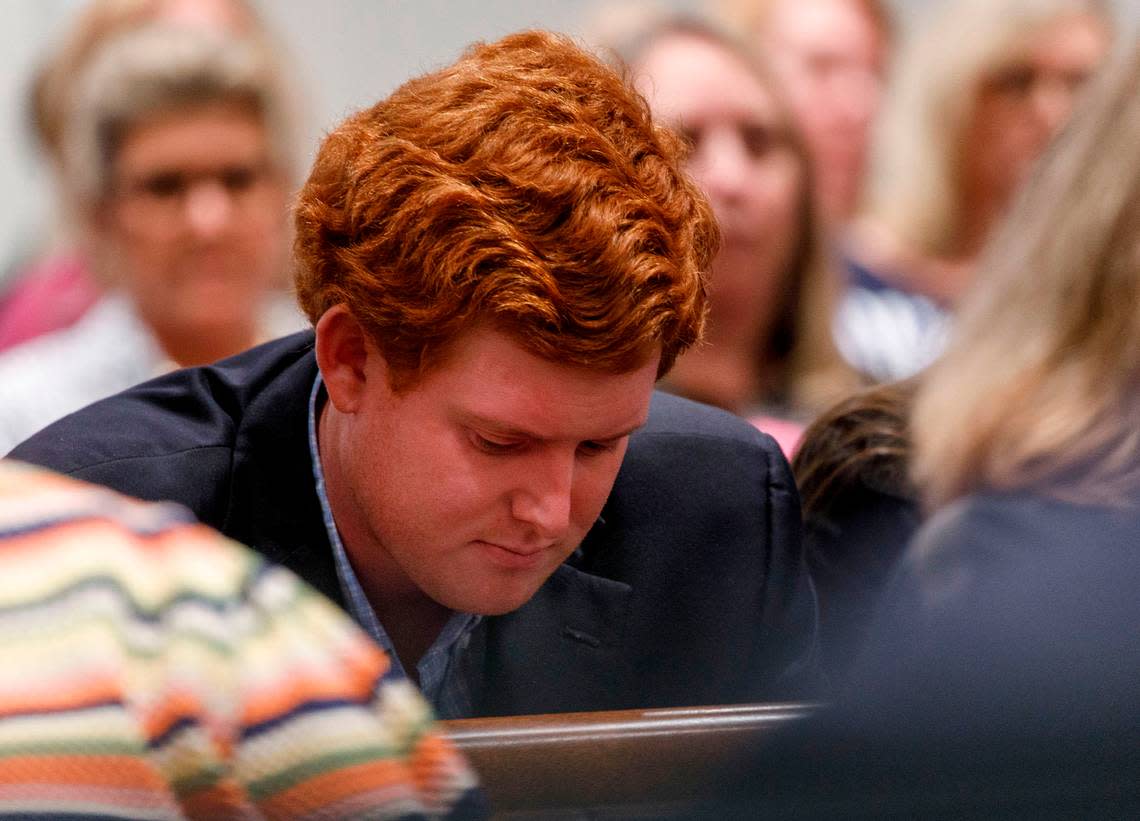
Murdaugh trial continues into fourth week
The fourth week of the Murdaugh trial could be the last for the prosecution to make its case.
Waters repeated Monday he expects to wrap the state’s case by the middle of this week, turning the trial over to Murdaugh’s defense team of Harpootlian and Jim Griffin to present their witnesses to the jury. Harpootlian said previously they need at least a week to present their case.
As a scheduling note, Newman said court will not be held President’s Day, Feb. 20.
By the end of last week, the state had presented 49 witnesses to the jury who testified to everything from cellphone data to Murdaugh’s behavior before, during and after his wife and son were killed at the family’s rural Colleton County estate on the night of June 7, 2021.
Many have veered away from the murders themselves to talk about alleged financial crimes Murdaugh is also charged with — thefts of millions of dollars from his law partners and clients whose money he held in trust, many of them children seriously injured in car accidents.
Prosecutors allege the looming revelation of those thefts motivated Murdaugh to kill in order to distract from his financial dealings. The disbarred Lowcountry attorney has yet to be tried on those charges, and the defense has called them irrelevant to the question of who killed Maggie and Paul.
